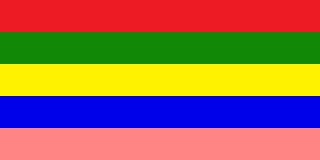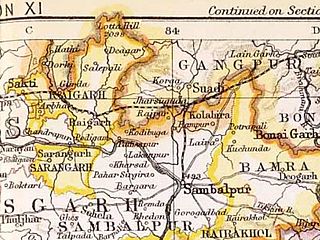
Korea State, currently spelt as Koriya, was a Rajput princely state in the Empire of India. After Indian independence in 1947, the ruler of Korea acceded to the Union of India on 1 January 1948, and Koriya was made part of Surguja District of Central Provinces and Berar province. In January 1950, "Central Provinces and Berar" province was renamed Madhya Pradesh state. After November 2000, Korea and the former princely state of Changbhakar became Koriya district of Chhattisgarh state.

Raigarh is a city in northern Chhattisgarh known as the 'Cultural capital of Chhattisgarh'; Raigarh is famous for its dance form “SUWA” and classical music; Raigarh is also known as Sanskritidhani.

The Eastern States Agency was an agency or grouping of princely states in eastern India, during the latter years of the British Raj. It was created in 1933, by the unification of the former Chhattisgarh States Agency and the Orissa States Agency; the agencies remained intact within the grouping. In 1936, the Bengal States Agency was added.
Sarangarh is a new district in the Indian state of Chhattisgarh.
Raja Nareshchandra Singh, was an Indian ruler of Sarangarh state in Raigarh District, Chhattisgarh. He also served as Chief Minister of undivided Madhya Pradesh.

Changbhakar State, also known as Chang Bhakar, was one of the small princely states of British Empire in India in the Chhattisgarh States Agency. It included 117 villages and had an area of 2,330 square kilometres (899 sq mi) with a 1941 population of 21,266 people. Bharatpur was the capital of the princely state.
Pushpa Devi Singh is an Indian politician who served on the 7th Lok Sabha for the Indian National Congress party.

Saraikela State also spelt Seraikela, Saraikella or Seraikella, was a small princely state in India during the British Raj, in the region that is now the Jharkhand state. Its capital was at Saraikela.

Sakti State was one of the princely states of India during the British Raj. It belonged to the Chhattisgarh States Agency, which later became the Eastern States Agency.

Raigarh was a princely state in India during the British Raj. The state was ruled by the Gond dynasty of Gond clan.

Kalahandi State, also known as Karond State, was one of the princely states of India during the British Raj. It was recognized as a state in 1874 and had its capital in Bhawanipatna. Its last ruler signed the accession to the Indian Union on 1 January 1948. The present titular head of the former state is Anant Pratap Deo who resides in the Kalahandi Palace in Bhawanipatna

Udaipur State was one of the princely states of India during the British Raj. The town of Dharamjaigarh was the former state's capital.

Khairagarh State was one of the princely states of India during the period of the British Raj. Khairagarh town in Khairagarh-Chhuikhadan-Gandai district of Chhattisgarh was the capital of the state and the seat of the Raja's residence.

Kawardha State was one of the princely states in the Central Provinces of India during the period of the British Raj. The capital of the state was Khairagarh town, in Kabirdham district of Chhattisgarh state. The Bhoramdeo Temple is located less than 20 km to the west of the main town.

Panna State was a kingdom and later princely state of colonial India, located in modern Panna district of Madhya Pradesh.

Sambalpur State, also known as Hirakhand Kingdom, was a kingdom founded in 1570. It ruled over Western Odisha and Eastern Chhattisgarh in central-eastern India prior to the Maratha occupation in 1800 AD. From 1849 AD, it was integrated with British Raj as a British District. Its capital was present-day Sambalpur city in Western Odisha.

Jashpur State was one of the princely states of India during the British Raj. The town of Jashpur was the former state's capital. The rulers were Rajputs of the Chauhan clan.

Kanker State was one of the princely states of India during the period of the British Raj. Its last ruler, Maharajadhiraj Bhanu Pratap Deo, signed the accession to the Indian Union in 1947.
















